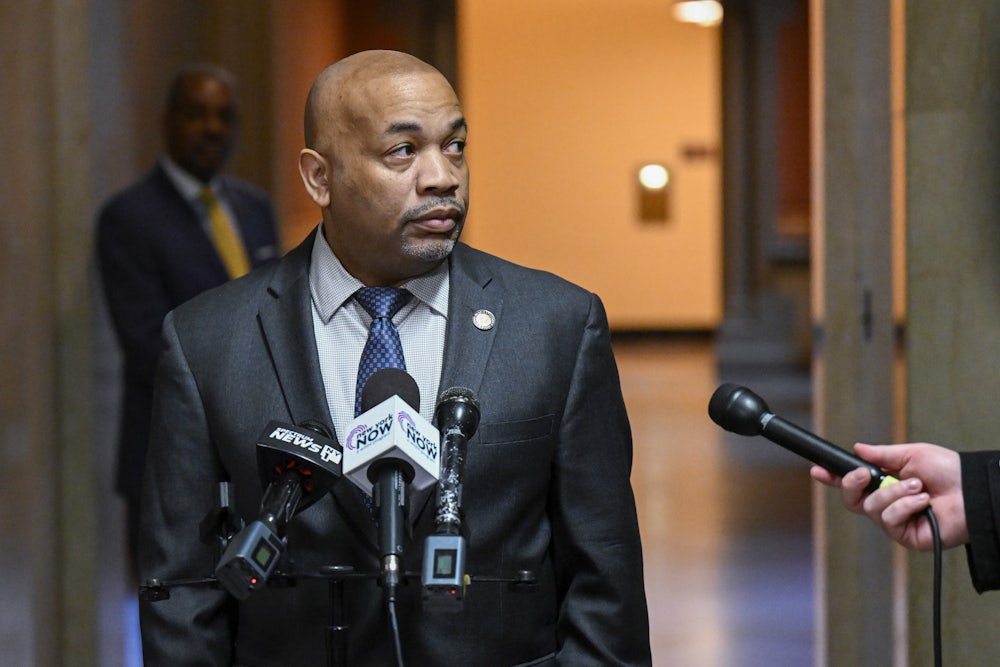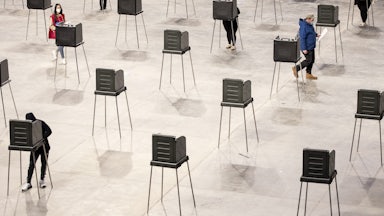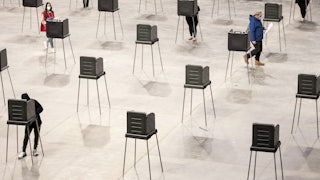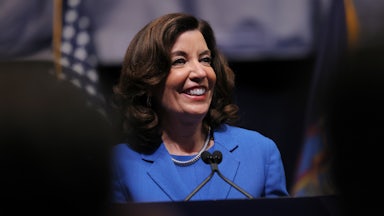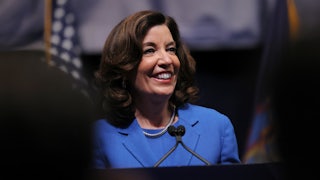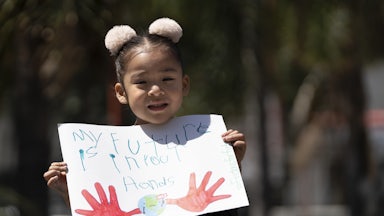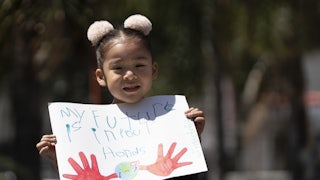Last week, the Build Public Renewables Act—which affirms the New York Power Authority’s ability to build publicly owned renewables and sets a deadline for shuttering its fossil fueled plants—died a quiet death in the early hours of the morning as the year’s legislative session wrapped up in overtime. It wasn’t climate-denying Republicans who kept Albany from passing climate legislation for the third year in a row. Instead, it was the leadership of New York state’s Democratic supermajority—all of whom have been eager to talk up the urgency of the climate crisis on the campaign trail. And the special interests who pressured them into the decision included more than the usual suspects: not just fossil fueled power providers but also solar energy trade associations.
As I wrote last week, the bill’s failure has national implications, as Democrats—facing the loss of the House in midterm elections this November—turn to states to start leading on emissions reductions. That one of the country’s bluest states has now failed to pass a major climate policy for three years in a row bodes poorly for those prospects. The coalitions on both sides of the BPRA showcase the increasingly complicated politics of climate policy, where rapid and deep decarbonization requires both a fight within the Democratic Party and against the narrow interests of companies that many of its members have seen as natural allies.
Traditionally, party leadership in New York state won’t bring a bill to a floor vote without being sure it will pass. The BPRA passed the Senate with a wide margin early last week. The Public Power New York Coalition—including the Energy Democracy Alliance, Food and Water Action, WEACT for Environmental Justice, and multiple Democratic Socialist of America chapters across the state—argued that the bill had secured 82 vote commitments in the Assembly, more than the 76 it would need to pass, and therefore should be put up for a vote there. Assembly Speaker Carl Heastie appears to have disagreed, and didn’t bring the bill to a vote before the legislative session ended on Saturday morning.
Zohran Mamdani—elected to represent Astoria, Queens, in the Assembly with DSA’s support in 2020—was whipping votes to bring his colleagues on board. “We were stuck at this point where we said more than 80 votes [were] ready to go. The speaker said there was insufficient support and there was no way to bridge that gap,” he told me.
Among the top concerns Mamdani heard from fellow Democrats were that the bill was too big to pass this year and unease around organized labor’s stance on it. The New York State AFL-CIO had opposed an earlier version but agreed to stay neutral based on pro-labor edits made to the version of the BPRA that would have gone up for a vote. “A number of legislators brought up that they had heard concerns from the governor’s team, or about whether it would be signed by the governor,” Mamdani added. “That’s one of the obstacles we face—not just in the chamber but in the executive as well.”
“Once it got out of the Senate, it became a matter of our word against Heastie’s in terms of how many votes we had,” said Patrick Robbins, coordinator of the Energy Democracy Alliance and a member of New York City DSA’s eco-socialist working group. “I am certain we had the votes. Even framing it that way is a little naïve, though. Heastie is an incredibly powerful politician, and if he announced he was bringing something to a vote, I promise votes would appear out of the woodwork.”
On Monday, Heastie’s office responded to multiple requests for comment by forwarding a public statement trumpeting the Assembly’s “long and proud tradition of working to protect our environment and recognizing the challenges to our climate,” citing bills that passed this session to put a two-year moratorium on cryptocurrency mining from fossil fuel power plants and implement energy efficiency standards for appliances. “We agree with the goals of the Build Public Renewables Act,” Heastie wrote. “The final version of the bill—amended two days prior to the scheduled close of our legislative session—had support in our conference, but not enough to move forward at this point.”
The statement asserted that Heastie had requested the chairs of the Assembly’s committees on energy, corporations, and environmental conservation convene a hearing on July 28 “to review this subject and get additional public input.” It’s an unusual move for the legislature to make, and one BPRA supporters see as evidence that Heastie’s office is feeling the heat from the failure to pass the bill before the close of session.
Mamdani, who serves on the Assembly’s Energy Committee, sees BPRA’s defeat this year as a mandate to elect more people with organizing backgrounds to serve in Albany. DSA is currently backing a slate of primary challengers to boost its numbers in the New York legislature; their elections are later this month. “I don’t think we need to get to a point where we have a numerical majority,” he said of DSA-backed elected officials. “What we need is a set of socialist organizer electeds who will go into this body, organize it, and ensure they are punching above their weight,” Mamdani argues. “There simply aren’t enough of us in that body doing that work of whipping and organizing and counting.”
The fiercest opposition to the BPRA came from the Independent Power Producers of New York, or IPPNY, and the Alliance for Clean Energy New York, or ACE NY, trade lobbies for merchant power generators who sell on to New York’s grid. As in other deregulated systems, New York’s investor-owned utilities—which distribute power—are barred from also generating it. Instead they procure it via the New York Independent System Operator, which connects generation capacity (largely owned by private companies) with utilities that sell electricity to consumers. The New York Power Authority currently owns and operates a third of New York’s transmission lines, as well as a fleet of generation facilities that provide about a quarter of the state’s electricity. The BPRA would require NYPA to close its fossil fueled generation facilities by 2030, and affirms its ability to build, own, and operate large-scale renewables.
In a memo opposing the bill, IPPNY and ACE NY called it “unnecessary,” arguing that private companies were already well on the way to achieving the goals set out by the the Climate and Community Protection Act, or CLCPA, in 2019, to achieve 100 percent zero-emissions electricity by 2040. “Clearly, renewable energy and energy storage industries are investing in New York today, and there is no evidence,” the memo states, “that the CLCPA’s requirements cannot be met by private developers,” who (they argue) have a proven track record of building renewables that NYPA would be hard-pressed to improve upon.
Signed onto that memo, as well, was the Solar Energy Industries Association, a national trade association representing solar companies. Asked about SEIA’s opposition to the bill, the group’s Washington, D.C.-based vice president of public affairs, Dan Whitten, suggested in an email that the BPRA would “allow a utility to build something without competing or bidding projects.”
There’s some clever framing here: While NYPA is in some sense a utility, it provides electricity only to institutional consumers, municipalities, businesses, and other public entities, while also selling a portion of the power it generates to the state’s open power market, managed by the New York Independent System Operator. It also operates under a different regulatory framework from investor-owned utilities like ConEd, which cannot generate electricity and would not be authorized to if the BPRA were implemented. Advertising from the anti-BPRA side suggested otherwise, with one Instagram ad warning, “Utilities stifle competition and raise prices.” It featured a darkened, menacing stock image that pops up among the first results in a Google Image search for “evil businessman.”
“Obviously we would never fight for utility generation,” the Energy Democracy Alliance’s Robbins told me when asked about BPRA opponents equating NYPA and IOU generation. “We are no fan of the private utilities, and that’s why we are fighting for a public option,” he said. “These business associations cannot win by being honest about what we’re doing.”
The Solar Energy Industries Association’s Whitten also offered another rationale: “Private industry can build projects faster, cheaper, and more efficiently,” he said. “When you take away solar businesses from the equation, you’re also taking away private investment, jobs, tax revenue, and new business opportunities from the community.”
I asked him to clarify, given that the bill wouldn’t actually restrict solar businesses but allow another competitor—NYPA—to enter the market. “Our view,” he responded, “is that the competitive market can provide clean energy more quickly and more cost-effectively (cheaply, if you prefer) than either state utilities or IOUs. We think NYPA should stick to its role of buying power from the market.”
There’s a contradiction here: SEIA and its allies—who rallied under the hashtag #CompetitiveCleanEnergy on Twitter—argue on the one hand that NYPA would be bad at generating renewable power. On the other, they warn that its doing so could essentially drive private solar companies out of business. Asked to continue the conversation by phone, Whitten responded, “We’ve said all we are going to say about this.”
Why would a national organization feel compelled to intervene in a state-level fight, particularly while in the midst of a tense battle with the White House over trade policy? (SEIA has been hammering the Commerce Department to end its probe into whether companies in four Southeast Asian countries are skirting tariffs by selling Chinese-made solar components to U.S. buyers.) It’s hard to imagine it would put up much of a fight if NYPA was really destined to be as impotent a force in renewables as it claims.
At the very least, the industry seems to fear losing market share to an entity whose raison d’être is generating massive amounts of electricity without needing to make a profit. But the involvement of a national power player like SEIA seems to speak to a deeper fear: that it could set a precedent for public institutions becoming an engine of renewables deployment in a field that—to date—has been dominated by the private sector.
“For too long, people have understood solar companies and any company invested in renewable energy as inherently good,” Mamdani told me. “We have to understand that in the two words that describe them, the more important word is not solar, but company. These private companies are terrified of having to engage in a competitive market where the state is an active participant.”
